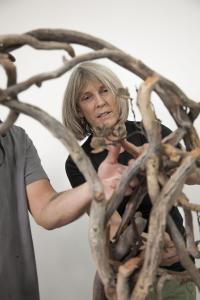
Famous UC Davis Alumna and Influential Professor Spotlighted in Museum Exhibitions
One of UC Davis’ most famous artist alumnae and an influential UC Davis professor emeritus will have major exhibitions at the Jan Shrem and Maria Manetti Shrem Museum of Art this fall.
“Deborah Butterfield: P.S. These are not horses” will examine the 50-year career of the artist who earned her undergraduate and graduate degrees in art at UC Davis and has gone on to worldwide acclaim. “Malaquías Montoya and the Legacies of a Printed Resistance” will look at the career of Montoya, who taught in both the art and Chicana and Chicano studies programs at UC Davis for two decades.
Both shows open Oct. 1 as part of the museum’s fall celebration from 2:30 to 5 p.m. Admission to the museum is free.
Artist’s sculptures are about more than horses

Butterfield (B.A., ’71, M.F.A. ’73, art) is best known for her sculptures based on equine figures. The exhibition will include that work, her recent sculptures of about wildfire, and pieces she made while a UC Davis student where she first used horses in her art.
The exhibition will also include art by the late UC Davis art professors Robert Arneson, Roy De Forest and William Wiley, with whom Butterfield studied. Butterfield will give a talk at the museum Oct. 22.
“The first horses were self-portraits; they were mares,” she said in a 2020 interview “This countered the historic iconic statues commemorating war, featuring generals sitting atop big stallions. These statues have been the metaphor for male domination and power.”
The title of the exhibition comes from a poem by Wiley, Butterfield’s lifelong mentor and friend, written on the occasion of a 1981 exhibition of her art.
Butterfield’s art is in many museum collections, including the Metropolitan Museum of Art and Whitney Museum of American Art, New York; the de Young Museum and San Francisco Museum of Modern Art, San Francisco; and the Hirshhorn Museum and Sculpture Garden, Washington, D.C. Last year she received a Lifetime Achievement Award from the International Sculpture Center.
A native of San Diego, California, Butterfield lives and works in Montana and Hawaii with her husband and artist John Buck (M.F.A., art, ’72).
The exhibition is on display through June 24, 2024. It was designed by Tim McNeil, a department of design faculty member.
Montoya’s artistic resistance passed on
“Malaquías Montoya and the Legacies of a Printed Resistance” explores the life, work and impact of Montoya, a professor emeritus who taught at UC Davis from 1989 to 2008 in the Department of Art and Art History and the Department of Chicano Studies. Montoya continues to be a teacher and mentor, primarily through Taller Arte del Nuevo Amanecer (TANA), an art center of Chicana and Chicano studies located in Woodland, California. He cofounded TANA in 2009.

Montoya was part of the Chicano arts movement that emerged in the 1960s and was founder the Mexican-American Liberation Art Front. The son of farmworkers in California’s Central Valley, he studied art at UC Berkeley on the G.I. Bill after serving in the U.S. Marine Corps. Before coming to UC Davis, Montoya taught at several San Francisco Bay Area colleges and universities, and was a founding faculty member of UC Berkeley Chicano studies in 1970.
He is best known for his silkscreen prints that address a wide range of social and political issues from the death penalty to farmworkers rights. He has also led many mural painting projects that often included UC Davis students and youth in the Woodland community.
“My personal views on art and society were formed by my being born into that silent and voiceless humanity,” Montoya has written. “Realizing later that it was not by choice that we remained mute but by the conscious effort of those in power, I realized that my art could only be that of protest — a protest against what I felt to be a death sentence.”
“Malaquías Montoya and the Legacies of a Printed Resistance” includes 23 of his prints, with additional works by his former students Xabi Soto Beleche and Alicia María Siu Bernal, along with Juan Fuentes, Ester Hernandez, Elyse Doyle-Martinez and members of the Royal Chicano Air Force.
The exhibition runs through May 6, 2024.
The Oakland Museum of California will also tell Montoya’s story with the exhibition “Por El Pueblo: The Legacy and Influence of Malaquías Montoya,” running Oct. 6, 2023 to June 30, 2024. This exhibition will explore his life and impact on others through his early to recent art, photographs, historical and familial ephemera, and work by artists from multiple generations influenced by Montoya.
Montoya is the father of Maceo Montoya, an artist, writer and professor of Chicana and Chicano studies and creative writing at UC Davis.
